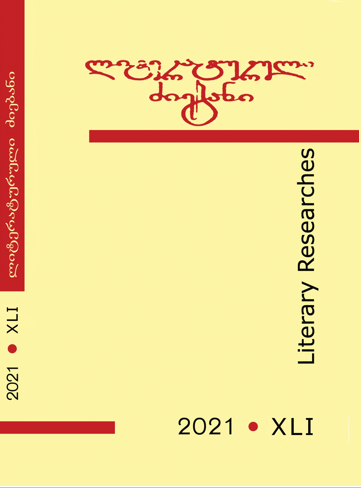Mentions about the Crucifixion of the Lord in the Georgian Editions of the “Life of St. Nino”
Published 2021-12-20
Keywords
- “Life of St. Nino”,
- Shatberdi-Chelishi edition,
- Motive of Crucifixion
How to Cite
Abstract
“Life of St. Nino” is the cornerstone of Georgian Christian culture. Studying of this work is very significant as it describes the events related to conversion of Kartli. “Life of St. Nino” elucidates numerous issues of Georgian culture and history. Together with the other problems, the passages related to the Biblical histories.
In Shatberdi-Chelishi edition, namely, in the record of Salome Ujarmeli, a woman of Dvini, care-taker of St. Nino Temple, tells about Christ’s coming into the world and his worldly deeds; saying that because of Christ’s miracles the Jews were possessed by envy, they sent the riders to ask their relatives to arrive to Jerusalem as soon as possible and indeed, the followers of Moses’s religion arrived from all countries, raised against Holy Spirit, crucified Christ and cast lots for his robe.
Similar passage is repeated in the other part of the work as well. In particular, in Sydonia’s record, stating that Priest Anna wrote to Sydonia’s grand-father, Ozi about Christ’s baptism and in four years Herod issued the order to all sons of Israel to arrive to be present at Christ’s execution. According to Sydonia, brother of her father’s mother, old Elioz visited Jerusalem.
Here, it is significant that Christ’s crucifixion was prepared in advance. Regarding the events, delivering of the order to Kartli and Elioz’s arrival to Jerusalem required at least three months. All above differs from the Gospel. In the sources available to us we could not find the data similar to those in “Life of St. Nino” while these passages are present in all editions of the work. It is hard to judge, whether this is an undoubted fact or not. Though if Elioz’s visit to Jerusalem is regarded as the truth, then we should believe in the above as well, as Elioz made a trip to attend the crucifixion on the basis of the letter from Jerusalem.
All above mentioned show, once more, how significant is the text of “Life of St. Nino” with respect of theology and historical narration.

